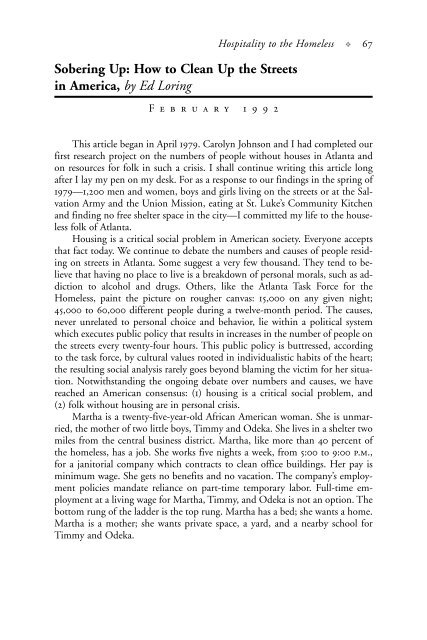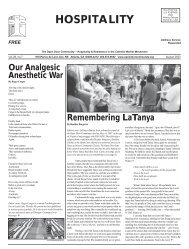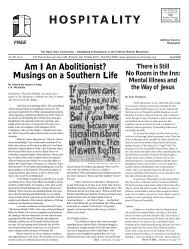- Page 2:
a work of hospitality
- Page 5 and 6:
To request additional copies of A W
- Page 8 and 9:
Contents Peter R. Gathje Introducti
- Page 10 and 11:
Contents ˜ ix Ed Loring Thony Gree
- Page 12 and 13:
Contents ˜ xi Ed Loring The Marks
- Page 14 and 15:
Introduction, by Peter R. Gathje Th
- Page 16 and 17:
Introduction ˜ 3 theology is forme
- Page 18:
Introduction ˜ 5 tyr is a witness;
- Page 21 and 22:
You know, peoples was not made to d
- Page 23 and 24:
10 ˜ A Work of Hospitality, 1982-2
- Page 25 and 26:
12 ˜ A Work of Hospitality, 1982-2
- Page 27 and 28:
14 ˜ A Work of Hospitality, 1982-2
- Page 29 and 30: 16 ˜ A Work of Hospitality, 1982-2
- Page 31 and 32: 18 ˜ A Work of Hospitality, 1982-2
- Page 33 and 34: 20 ˜ A Work of Hospitality, 1982-2
- Page 35 and 36: 22 ˜ A Work of Hospitality, 1982-2
- Page 37 and 38: 24 ˜ A Work of Hospitality, 1982-2
- Page 39 and 40: 26 ˜ A Work of Hospitality, 1982-2
- Page 41 and 42: 28 ˜ A Work of Hospitality, 1982-2
- Page 43 and 44: 30 ˜ A Work of Hospitality, 1982-2
- Page 45 and 46: 32 ˜ A Work of Hospitality, 1982-2
- Page 47 and 48: 34 ˜ A Work of Hospitality, 1982-2
- Page 49 and 50: 36 ˜ A Work of Hospitality, 1982-2
- Page 51 and 52: 38 ˜ A Work of Hospitality, 1982-2
- Page 53 and 54: 40 ˜ A Work of Hospitality, 1982-2
- Page 55 and 56: 42 ˜ A Work of Hospitality, 1982-2
- Page 57 and 58: 44 ˜ A Work of Hospitality, 1982-2
- Page 59 and 60: 46 ˜ A Work of Hospitality, 1982-2
- Page 61 and 62: 48 ˜ A Work of Hospitality, 1982-2
- Page 64 and 65: Part II hospitality to the homeless
- Page 66 and 67: Entering the World of the Homeless,
- Page 68 and 69: Hospitality to the Homeless ˜ 55 w
- Page 70 and 71: Hospitality to the Homeless ˜ 57 t
- Page 72 and 73: Hospitality to the Homeless ˜ 59 t
- Page 74 and 75: Hospitality to the Homeless ˜ 61 a
- Page 76 and 77: Homelessness and Slavery, by Elizab
- Page 78 and 79: Hospitality to the Homeless ˜ 65 l
- Page 82 and 83: Hospitality to the Homeless ˜ 69 m
- Page 84 and 85: Hospitality to the Homeless ˜ 71 A
- Page 86 and 87: Hospitality to the Homeless ˜ 73 f
- Page 88 and 89: Hospitality to the Homeless ˜ 75 t
- Page 90 and 91: Hospitality to the Homeless ˜ 77 e
- Page 92 and 93: Butler Street Breakfast, Part 2, by
- Page 94 and 95: Hospitality to the Homeless ˜ 81 h
- Page 96 and 97: Hospitality to the Homeless ˜ 83 t
- Page 98 and 99: Hospitality to the Homeless ˜ 85 i
- Page 100 and 101: The Politics of Cleanliness, by Mar
- Page 102 and 103: Hospitality to the Homeless ˜ 89 t
- Page 104 and 105: Hospitality to the Homeless ˜ 91 p
- Page 106 and 107: Hospitality to the Homeless ˜ 93 T
- Page 108 and 109: Hospitality to the Homeless ˜ 95 E
- Page 110 and 111: Hospitality to the Homeless ˜ 97 t
- Page 112 and 113: Hospitality to the Homeless ˜ 99 t
- Page 114 and 115: In Defense of Band-Aids, by Ed Lori
- Page 116 and 117: Hospitality to the Homeless ˜ 103
- Page 118 and 119: Hospitality to the Homeless ˜ 105
- Page 120 and 121: a vow that you will not rest until
- Page 122 and 123: Hospitality to the Homeless ˜ 109
- Page 124 and 125: Hospitality to the Homeless ˜ 111
- Page 126 and 127: Hospitality to the Homeless ˜ 113
- Page 128 and 129: Hospitality to the Homeless ˜ 115
- Page 130 and 131:
Hospitality to the Homeless ˜ 117
- Page 132 and 133:
Hospitality to the Homeless ˜ 119
- Page 134 and 135:
Hospitality to the Homeless ˜ 121
- Page 136 and 137:
Hospitality to the Homeless ˜ 123
- Page 138 and 139:
Hospitality to the Homeless ˜ 125
- Page 140 and 141:
Hospitality to the Homeless ˜ 127
- Page 142:
Hospitality to the Homeless ˜ 129
- Page 145 and 146:
The spirit of the Lord God is upon
- Page 147 and 148:
134 ˜ A Work of Hospitality, 1982-
- Page 149 and 150:
136 ˜ A Work of Hospitality, 1982-
- Page 151 and 152:
138 ˜ A Work of Hospitality, 1982-
- Page 153 and 154:
140 ˜ A Work of Hospitality, 1982-
- Page 155 and 156:
142 ˜ A Work of Hospitality, 1982-
- Page 157 and 158:
144 ˜ A Work of Hospitality, 1982-
- Page 159 and 160:
146 ˜ A Work of Hospitality, 1982-
- Page 161 and 162:
148 ˜ A Work of Hospitality, 1982-
- Page 163 and 164:
150 ˜ A Work of Hospitality, 1982-
- Page 165 and 166:
152 ˜ A Work of Hospitality, 1982-
- Page 167 and 168:
154 ˜ A Work of Hospitality, 1982-
- Page 169 and 170:
156 ˜ A Work of Hospitality, 1982-
- Page 171 and 172:
158 ˜ A Work of Hospitality, 1982-
- Page 173 and 174:
160 ˜ A Work of Hospitality, 1982-
- Page 175 and 176:
162 ˜ A Work of Hospitality, 1982-
- Page 177 and 178:
164 ˜ A Work of Hospitality, 1982-
- Page 179 and 180:
166 ˜ A Work of Hospitality, 1982-
- Page 181 and 182:
168 ˜ A Work of Hospitality, 1982-
- Page 183 and 184:
170 ˜ A Work of Hospitality, 1982-
- Page 185 and 186:
172 ˜ A Work of Hospitality, 1982-
- Page 187 and 188:
174 ˜ A Work of Hospitality, 1982-
- Page 189 and 190:
176 ˜ A Work of Hospitality, 1982-
- Page 191 and 192:
178 ˜ A Work of Hospitality, 1982-
- Page 193 and 194:
180 ˜ A Work of Hospitality, 1982-
- Page 195 and 196:
182 ˜ A Work of Hospitality, 1982-
- Page 197 and 198:
184 ˜ A Work of Hospitality, 1982-
- Page 199 and 200:
186 ˜ A Work of Hospitality, 1982-
- Page 201 and 202:
188 ˜ A Work of Hospitality, 1982-
- Page 203 and 204:
190 ˜ A Work of Hospitality, 1982-
- Page 205 and 206:
192 ˜ A Work of Hospitality, 1982-
- Page 207 and 208:
194 ˜ A Work of Hospitality, 1982-
- Page 209 and 210:
196 ˜ A Work of Hospitality, 1982-
- Page 211 and 212:
198 ˜ A Work of Hospitality, 1982-
- Page 213 and 214:
200 ˜ A Work of Hospitality, 1982-
- Page 215 and 216:
202 ˜ A Work of Hospitality, 1982-
- Page 217 and 218:
We are an experiment with truth. We
- Page 219 and 220:
206 ˜ A Work of Hospitality, 1982-
- Page 221 and 222:
208 ˜ A Work of Hospitality, 1982-
- Page 223 and 224:
210 ˜ A Work of Hospitality, 1982-
- Page 225 and 226:
212 ˜ A Work of Hospitality, 1982-
- Page 227 and 228:
214 ˜ A Work of Hospitality, 1982-
- Page 229 and 230:
216 ˜ A Work of Hospitality, 1982-
- Page 231 and 232:
218 ˜ A Work of Hospitality, 1982-
- Page 233 and 234:
220 ˜ A Work of Hospitality, 1982-
- Page 235 and 236:
222 ˜ A Work of Hospitality, 1982-
- Page 237 and 238:
224 ˜ A Work of Hospitality, 1982-
- Page 239 and 240:
226 ˜ A Work of Hospitality, 1982-
- Page 241 and 242:
228 ˜ A Work of Hospitality, 1982-
- Page 243 and 244:
230 ˜ A Work of Hospitality, 1982-
- Page 245 and 246:
232 ˜ A Work of Hospitality, 1982-
- Page 247 and 248:
234 ˜ A Work of Hospitality, 1982-
- Page 249 and 250:
236 ˜ A Work of Hospitality, 1982-
- Page 251 and 252:
238 ˜ A Work of Hospitality, 1982-
- Page 253 and 254:
240 ˜ A Work of Hospitality, 1982-
- Page 255 and 256:
242 ˜ A Work of Hospitality, 1982-
- Page 257 and 258:
244 ˜ A Work of Hospitality, 1982-
- Page 259 and 260:
246 ˜ A Work of Hospitality, 1982-
- Page 261 and 262:
248 ˜ A Work of Hospitality, 1982-
- Page 263 and 264:
250 ˜ A Work of Hospitality, 1982-
- Page 265 and 266:
252 ˜ A Work of Hospitality, 1982-
- Page 267 and 268:
254 ˜ A Work of Hospitality, 1982-
- Page 269 and 270:
256 ˜ A Work of Hospitality, 1982-
- Page 271 and 272:
258 ˜ A Work of Hospitality, 1982-
- Page 274 and 275:
Part V saints and martyrs calvin ki
- Page 276 and 277:
Amazing Grace: Willie Dee Wimberly,
- Page 278 and 279:
Grace Us with Your Presence, by Eli
- Page 280 and 281:
His Name Is Ralph, by Murphy Davis
- Page 282 and 283:
Saints and Martyrs ˜ 269 years ins
- Page 284 and 285:
Saints and Martyrs ˜ 271 brother c
- Page 286 and 287:
Saints and Martyrs ˜ 273 race is t
- Page 288 and 289:
Saints and Martyrs ˜ 275 will. Som
- Page 290 and 291:
Saints and Martyrs ˜ 277 Carl was
- Page 292 and 293:
Saints and Martyrs ˜ 279 black han
- Page 294 and 295:
Saints and Martyrs ˜ 281 at restau
- Page 296 and 297:
meant counting time as precious on
- Page 298 and 299:
Saints and Martyrs ˜ 285 ple aroun
- Page 300 and 301:
Saints and Martyrs ˜ 287 his anger
- Page 302 and 303:
Saints and Martyrs ˜ 289 wouldn’
- Page 304 and 305:
Saints and Martyrs ˜ 291 all kinds
- Page 306 and 307:
Saints and Martyrs ˜ 293 ness land
- Page 308 and 309:
S. A. Williams: Dereliction and the
- Page 310 and 311:
According to custom the welcomed gu
- Page 312 and 313:
Saints and Martyrs ˜ 299 Until you
- Page 314 and 315:
Part VI the theology of hospitality
- Page 316 and 317:
Invitation to the Body of Christ, b
- Page 318 and 319:
The Theology of Hospitality ˜ 305
- Page 320 and 321:
The Theology of Hospitality ˜ 307
- Page 322 and 323:
The Theology of Hospitality ˜ 309
- Page 324 and 325:
The Theology of Hospitality ˜ 311
- Page 326 and 327:
The Theology of Hospitality ˜ 313
- Page 328 and 329:
The Theology of Hospitality ˜ 315
- Page 330 and 331:
The Theology of Hospitality ˜ 317
- Page 332 and 333:
The Theology of Hospitality ˜ 319
- Page 334 and 335:
The Theology of Hospitality ˜ 321
- Page 336 and 337:
The Theology of Hospitality ˜ 323
- Page 338 and 339:
The Theology of Hospitality ˜ 325
- Page 340 and 341:
The Theology of Hospitality ˜ 327
- Page 342 and 343:
The Theology of Hospitality ˜ 329
- Page 344 and 345:
The Theology of Hospitality ˜ 331
- Page 346 and 347:
The Theology of Hospitality ˜ 333
- Page 348 and 349:
The Theology of Hospitality ˜ 335
- Page 350 and 351:
The Theology of Hospitality ˜ 337
- Page 352 and 353:
The Theology of Hospitality ˜ 339
- Page 354 and 355:
Afterword: The Open Door Community
- Page 356 and 357:
Afterword ˜ 343 tures and mores, i
- Page 358 and 359:
Afterword ˜ 345 Son as an offering
- Page 360 and 361:
Afterword ˜ 347 ers have such a wa
- Page 362:
advocacy for justice could be drain
- Page 365 and 366:
352 ˜ Reading List Hughes, Langsto
- Page 367 and 368:
354 ˜ Open Door Timeline homeless.
- Page 369 and 370:
356 ˜ Contributors Ed Loring is a
- Page 371 and 372:
358 ˜ Index of Names and Subjects
- Page 373 and 374:
360 ˜ Index of Names and Subjects
- Page 375 and 376:
362 ˜ Index of Names and Subjects
- Page 377 and 378:
364 ˜ Index of Names and Subjects
- Page 379 and 380:
366 ˜ Index of Names and Subjects
- Page 382 and 383:
Index of Scripture References ˜ Ol







